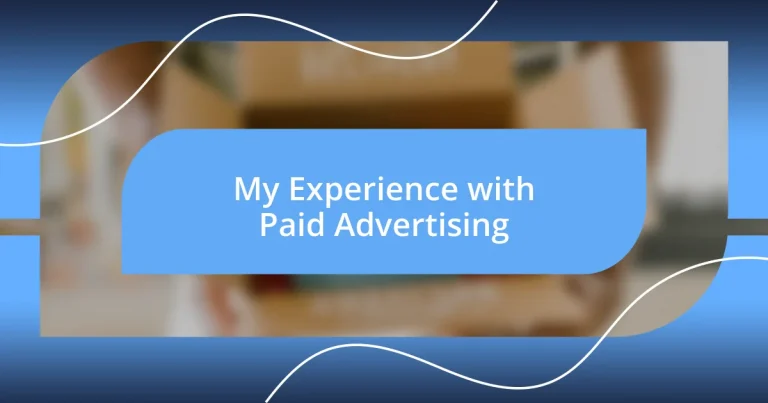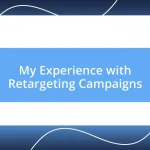Key takeaways:
- Setting clear advertising goals is crucial for guiding strategy and measuring success, transitioning anxiety into a structured plan of action.
- Effectively targeting your audience based on interests and demographics leads to higher engagement and better results than casting a wide net.
- Measuring success involves a holistic approach, focusing on engagement metrics and customer journeys rather than just impressions and clicks.

Understanding Paid Advertising Basics
Paid advertising is essentially the practice of paying for promotional space to reach a wider audience. I remember my first experience diving into this world; I felt a mix of excitement and anxiety. What if I invested all this money, and it didn’t pay off? That fear is common, but understanding how to strategically allocate your budget can help ease those worries.
There are various forms of paid advertising, such as pay-per-click (PPC) and social media ads. I was initially overwhelmed by the options available, like Google Ads or Facebook sponsored posts. Each platform has its unique audience and targeting capabilities. It’s crucial to figure out where your audience spends their time and tailor your approach accordingly. Why not think about where you find yourself most often online?
One key aspect I learned is the importance of setting clear goals. When I first started, my objectives were vague, leading to a lack of focus and poor results. Having specific metrics to measure—like conversions or engagement rates—gives your advertising a purpose. What target do you want to hit? Defining that can turn your anxiety into excitement as each click leads you closer to your goal.
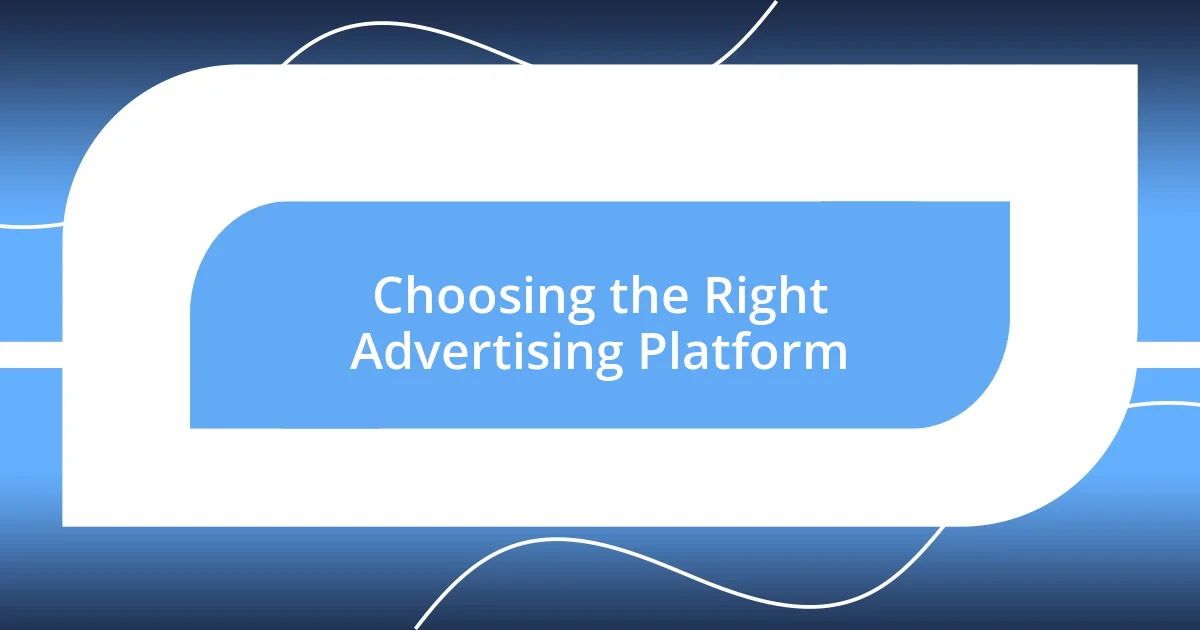
Choosing the Right Advertising Platform
When it comes to choosing the right advertising platform, personal experience plays a huge role in making that decision. I remember weighing my options between Facebook and Google Ads. Facebook offered me a chance to visualize my product through eye-catching imagery, while Google allowed me to directly target users actively searching for what I had to offer. The stark difference in approaching each audience left me pondering, which platform does my target audience prefer? Ultimately, identifying where my potential customers are more engaged helped clarify my choice.
In addition to audience engagement, budget and cost-effectiveness are crucial factors to consider. While I initially thought a larger budget meant better results, I quickly realized that strategic spending often trumps sheer volume. During one campaign, I noticed that my Google Ads had a higher cost-per-click but led to more qualified leads compared to a less expensive social media ad that didn’t resonate with my audience. This realization emphasized the need for a balance between cost and engagement when selecting the right platform.
Now, let’s compare some common advertising platforms based on key factors like audience reach, targeting options, and overall costs. This can help simplify your decision-making process:
| Platform | Audience Reach | Targeting Options | Cost |
|---|---|---|---|
| Google Ads | High | Keyword, Location, Demographics | Varies |
| Facebook Ads | Very High | Interests, Behavior, Demographics | Generally Lower |
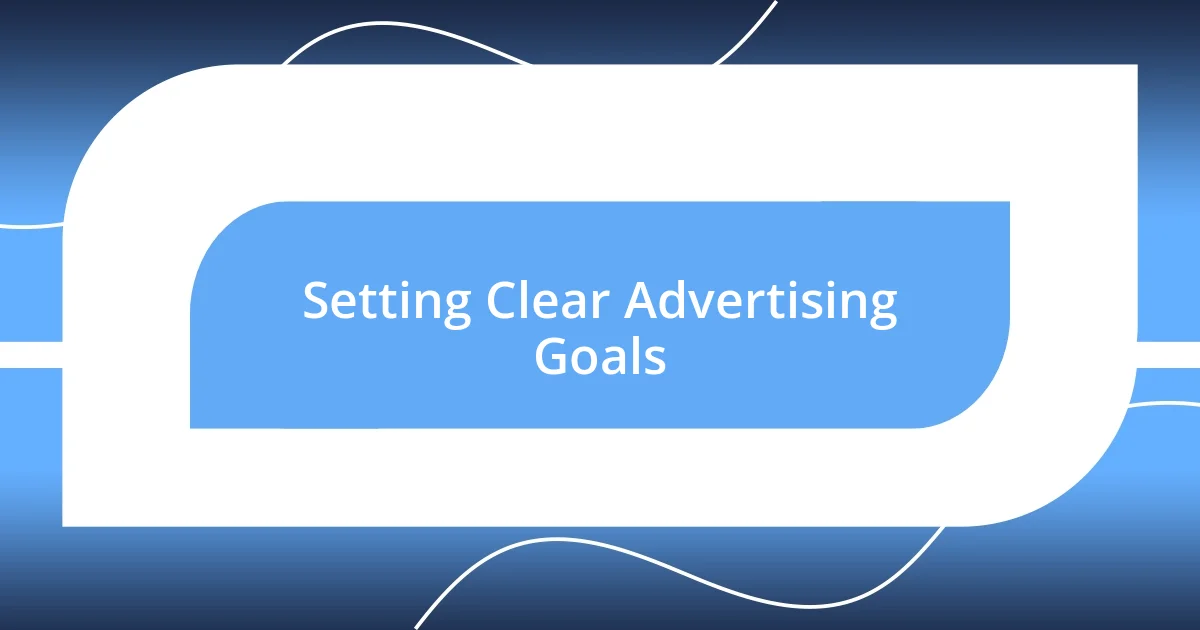
Setting Clear Advertising Goals
When I reflect on my journey with paid advertising, one of the most significant lessons I’ve learned is the importance of setting clear advertising goals from the outset. Early on, I remember feeling adrift without a precise target. It felt like shooting arrows in the dark; the frustration was palpable. Now, I ensure that each campaign has well-defined objectives. Whether you’re aiming for brand awareness or lead generation, pinpointing these goals provides clarity and guides your strategy.
To help ensure your advertising efforts are focused, consider these key aspects when setting goals:
- Specific: Define what you want to achieve, such as a 20% increase in website traffic.
- Measurable: Use metrics like ROI or conversion rates to track progress.
- Achievable: Set realistic goals based on your budget and resources.
- Relevant: Make sure your goals align with your overall business objectives.
- Time-bound: Establish a timeline for achieving your goals, like within the next quarter.
I can’t stress enough how establishing these guidelines transformed my anxiety into a structured plan of action. Having tangible milestones to work towards made each small victory feel more rewarding.
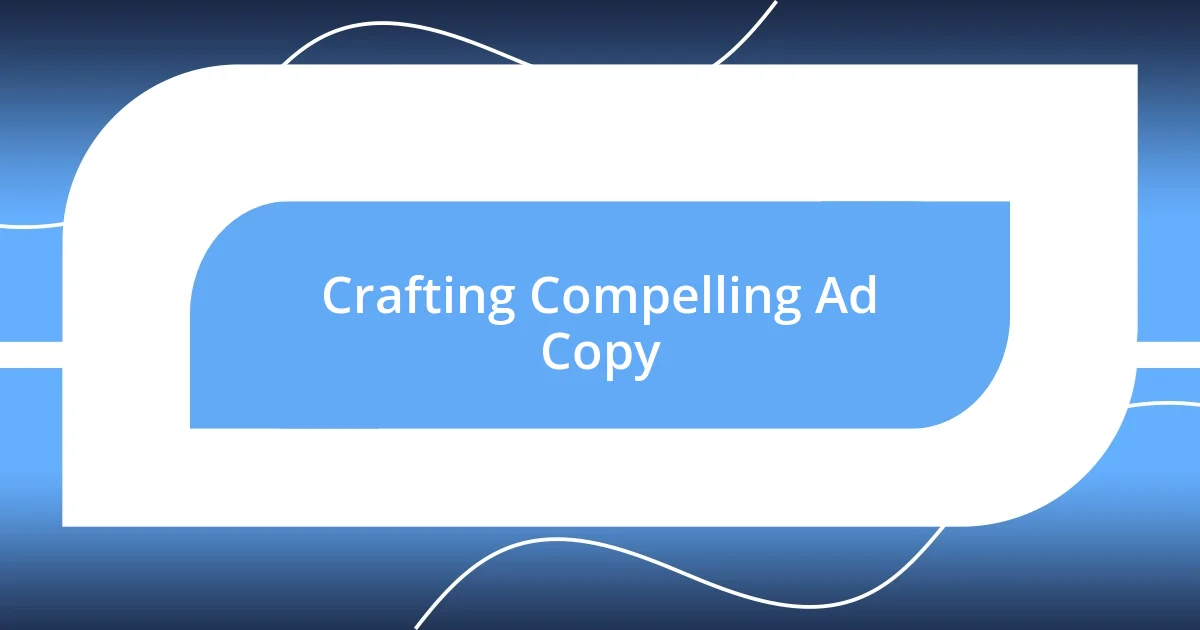
Crafting Compelling Ad Copy
Crafting compelling ad copy is both an art and a science, shaped by understanding your audience’s needs. I learned early on that headlines are especially crucial. In one campaign, I tested different headlines: one that was straightforward versus another that asked a thought-provoking question. The second option saw a staggering increase in click-through rates, which made me wonder—what resonates more with people? Sometimes, it’s the emotional connection that truly drives engagement.
As I dove deeper into ad copy, I discovered the power of storytelling. I remember designing an ad for a local service where I shared a brief success story about a customer’s positive experience. It wasn’t just about the service; it was about the transformation. This personal touch made the ad feel relatable. It got me thinking about how often we overlook the human element in our messaging.
Finally, incorporating strong calls-to-action (CTAs) is a game changer. One particular campaign flopped because I was too vague about what I wanted potential customers to do next. After that, I experimented with direct CTAs like “Get your free trial today!” and “Join our community now!” The results were eye-opening. A clear invitation can make all the difference, prompting the audience to take that crucial next step. Have you considered how your CTAs could be stronger? I know I constantly assess if mine encourage the action I want.

Targeting Your Audience Effectively
Targeting your audience effectively is like finding the perfect key for a lock. When I first ventured into paid advertising, I was casting a wide net, hoping to catch anything that represented potential customers. However, the reality hit me hard: the broader the audience, the weaker the results. In one campaign, I refined my targeting based on interests, demographics, and behaviors. It was as if I had shifted from trying to please everyone to speaking directly to my ideal customer. That precision led to a noticeable uptick in engagement, which was encouraging.
One key experience that stands out is when I used social media analytics to tailor a campaign for a niche audience. By diving into the data, I discovered the unique preferences of this group. In doing so, I realized how much more impactful a tailored approach can be. Instead of just promoting a product, I spoke to their specific needs and pain points. It’s fascinating to think: how many times do we overlook valuable insights that could inform our strategies?
Ultimately, I learned that effective targeting means continuously refining my approach. Every campaign offers new data to sift through, allowing me to better understand my audience. I often ask myself: what adjustments can I make now to connect even deeper? By embracing this mindset, I’ve turned data into a helpful tool to shape future advertisements. It becomes less about intuition and more about making informed decisions, which is incredibly empowering.

Measuring Advertising Success
Measuring advertising success is one of those tasks that can feel overwhelming at times, but I’ve found it immensely rewarding. Early in my advertising journey, I focused heavily on metrics like impressions and clicks. However, as I dove deeper, I realized that engagement rates and conversion metrics told a much richer story. It makes you wonder—are we often chasing the wrong numbers?
One memorable campaign taught me the value of tracking customer journeys. I set up unique landing pages for different ads, and the insights were eye-opening. I saw not just who clicked but where they dropped off in the process. This information illuminated the path of engagement, helping me adjust my messaging and improve conversion rates. Isn’t it fascinating how small tweaks in our strategy can lead to monumental results?
Looking back, I now prioritize a holistic view of success. Beyond just numbers, I analyze customer feedback and retention rates. This multifaceted approach ensures I’m not just celebrating a short-term win but building lasting relationships. Have you ever considered that the real measure of success might be the lasting impression you leave on your audience? For me, it’s about creating bonds that extend beyond a single transaction.

Scaling Your Advertising Efforts
Scaling Your Advertising Efforts
Scaling your advertising efforts can feel like a tightrope walk at times. When I first tried to boost my campaigns, I worried about spreading my budget too thin. I remember one instance where I expanded my reach too quickly, leading to wasted ad spend with minimal returns. Lesson learned: taking measured steps is key. Focusing on scaling gradually allows for refinement in both content and targeting without sacrificing quality.
One strategy that worked wonders for me was reinvesting profits into ads that showed promise. For example, after a successful campaign on Instagram, I used the revenue generated to fund a larger Facebook push, refining my targeting even further. It was thrilling to watch my initial success snowball into greater visibility and audience connection. How often do we underestimate the power of momentum in advertising?
I also began experimenting with A/B testing as I scaled up my efforts. This allowed me to see not just what worked well, but why it worked. I vividly recall testing different ad creatives and copy against each other. Each test taught me invaluable lessons about my audience’s preferences and behavior. It’s a journey of discovery—are you prepared to uncover what truly resonates with your consumers? The combined insights drove my scaling process, ultimately leading to more strategic and impactful advertising campaigns.












